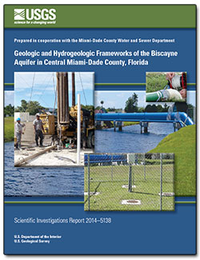Geologic and hydrogeologic frameworks of the Biscayne aquifer in central Miami-Dade County, Florida
Links
- More information: USGS Index Page
- Document: Report
- Plates:
- Appendixes:
- Download citation as: RIS | Dublin Core
Abstract
Evaluations of the lithostratigraphy, lithofacies, paleontology, ichnology, depositional environments, and cyclostratigraphy from 11 test coreholes were linked to geophysical interpretations, and to results of hydraulic slug tests of six test coreholes at the Snapper Creek Well Field (SCWF), to construct geologic and hydrogeologic frameworks for the study area in central Miami-Dade County, Florida. The resulting geologic and hydrogeologic frameworks are consistent with those recently described for the Biscayne aquifer in the nearby Lake Belt area in Miami-Dade County and link the Lake Belt area frameworks with those developed for the SCWF study area. The hydrogeologic framework is characterized by a triple-porosity pore system of (1) matrix porosity (mainly mesoporous interparticle porosity, moldic porosity, and mesoporous to megaporous separate vugs), which under dynamic conditions, produces limited flow; (2) megaporous, touching-vug porosity that commonly forms stratiform groundwater passageways; and (3) conduit porosity, including bedding-plane vugs, decimeter-scale diameter vertical solution pipes, and meter-scale cavernous vugs. The various pore types and associated permeabilities generally have a predictable vertical spatial distribution related to the cyclostratigraphy.
The Biscayne aquifer within the study area can be described as two major flow units separated by a single middle semiconfining unit. The upper Biscayne aquifer flow unit is present mainly within the Miami Limestone at the top of the aquifer and has the greatest hydraulic conductivity values, with a mean of 8,200 feet per day. The middle semiconfining unit, mainly within the upper Fort Thompson Formation, comprises continuous to discontinuous zones with (1) matrix porosity; (2) leaky, low permeability layers that may have up to centimeter-scale vuggy porosity with higher vertical permeability than horizontal permeability; and (3) stratiform flow zones composed of fossil moldic porosity, burrow related vugs, or irregular vugs. Flow zones with a mean hydraulic conductivity of 2,600 feet per day are present within the middle semiconfining unit, but none of the flow zones are continuous across the study area. The lower Biscayne aquifer flow unit comprises a group of flow zones in the lower part of the aquifer. These flow zones are present in the lower part of the Fort Thompson Formation and in some cases within the limestone or sandstone or both in the uppermost part of the Pinecrest Sand Member of the Tamiami Formation. The mean hydraulic conductivity of major flow zones within the lower Biscayne aquifer flow unit is 5,900 feet per day, and the mean value for minor flow zones is 2,900 feet per day. A semiconfining unit is present beneath the Biscayne aquifer. The boundary between the two hydrologic units is at the top or near the top of the Pinecrest Sand Member of the Tamiami Formation. The lower semiconfining unit has a hydraulic conductivity of less than 350 feet per day.
The most productive zones of groundwater flow within the two Biscayne aquifer flow units have a characteristic pore system dominated by stratiform megaporosity related to selective dissolution of an Ophiomorpha-dominated ichnofabric. In the upper flow unit, decimeter-scale vertical solution pipes that are common in some areas of the SCWF study area contribute to high vertical permeability compared to that in areas without the pipes. Cross-hole flowmeter data collected from the SCWF test coreholes show that the distribution of vuggy porosity, matrix porosity, and permeability within the Biscayne aquifer of the SCWF is highly heterogeneous and anisotropic.
Groundwater withdrawals from production well fields in southeastern Florida may be inducing recharge of the Biscayne aquifer from canals near the well fields that are used for water-management functions, such as flood control and well-field pumping. The SCWF was chosen as a location within Miami-Dade County to study the potential for such recharge to the Biscayne aquifer from the C–2 (Snapper Creek) canal that roughly divides the well field in half. Geologic, hydrogeologic, and hydraulic information on the aquifer collected during construction of monitoring wells within the SCWF could be used to evaluate the groundwater flow budget at the well-field scale.
Study Area
| Publication type | Report |
|---|---|
| Publication Subtype | USGS Numbered Series |
| Title | Geologic and hydrogeologic frameworks of the Biscayne aquifer in central Miami-Dade County, Florida |
| Series title | Scientific Investigations Report |
| Series number | 2014-5138 |
| DOI | 10.3133/sir20145138 |
| Year Published | 2014 |
| Language | English |
| Publisher | U.S. Geological Survey |
| Publisher location | Reston, VA |
| Contributing office(s) | Florida Water Science Center |
| Description | Report: viii, 66 p.; 4 Appendices; 3 Plates: 36 X 29.17 or smaller |
| Country | United States |
| State | Florida |
| County | Miami-Dade County |
| Online Only (Y/N) | Y |


